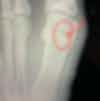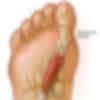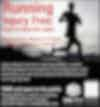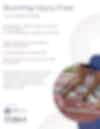March 2022 Newsletter
Note from the Editor
This is a season of transitions. For those of us who thrive on routine, it can be a difficult time of year. Maybe you find yourself having to make endless adjustments in your weekly running plans to account for wildly fluctuating weather scenarios. Or maybe you've gotten used to the long, dark days, and you're not sure what to do with all this new daylight in the evening. Perhaps you're realizing that training season will begin soon, and you need to start transitioning out of a season of rest. Or maybe you're dealing with an injury - and that's a big shift into a different mental and physical space. Or maybe you've recently healed up and are transitioning back into running, great but scary! Transitions can be hard (unless you thrive on instability - please share your secrets). How can we cope with this period? Take care of yourself - know your body, avoid injury, make new friends. Keep on moving - plan some summer races, get out on group runs. Find the little pieces that provide readily accessible joy - like running playlists, or a local road route to take you through this fickle season. This newsletter is full of options for these things. When the weather, the state of the world, and life feels tumultuous, let all the wonderful UVRC members run alongside you.
Editor
Anne Farrell
UVRC Newsletter Team
Article Collection
Robert Jones
UVRC Newsletter Team
Table of Contents
- Walk, Bike, Ride Leb – Online Survey by Robert Jones
- Letter from a Board Member: I Love the Rhythm: A “Mathematical” Pace and BPM Analysis by Robert Jones
- Michael Herron by Matt Sherman
- March 2022 "Trail" by Jennifer Hansen
- Skip's Run 2022 by Erik Ferguson
- UVRC runners meet Tour de Woodstock by Hannah Taska
- What is a Sesamoid Bone and Why All Runners Should Care by Kali Smolen
- Grand Prix 2022 Announcement by Geoff Dunbar
- Be Fit Running Clinics by Eric Ellingson
Walk, Bike, Ride Leb – Online Survey
By: Robert Jones
What would help you and others to get around Lebanon by foot, bike and bus more often--and with less stress? Take a visual stroll with us through the Walk, Bike, Ride Leb plan’s themes and take a brief survey to share your thoughts with the City of Lebanon decision-makers. Access the Public Input Portal here.
Walk, Bike, Ride Leb will be a plan to create a safe, comfortable, and connected walking and bicycling network in the City of Lebanon, including connections to public transportation. Learn more at https://lebanonnh.gov/WalkBikeRideLeb.
I Love the Rhythm: A “Mathematical” Pace and BPM Analysis
By: Robert Jones
Hi Friends, if ever you were self conscious about sending us your articles fear no more! For I am going to fall on my sword and set a precedent in “things that I wouldn’t want known by the public so I’ll keep them to myself” by making my dubious math skills public! It can only go up from here y’all!
So in honor of this month’s theme (that I made up) I wrote an article about what I love about running. And what I love is music, or rather being able to incorporate music into my running. It’s a great time for me to jam to some bops and not have to worry about anything or anyone else, or anyone’s unsolicited and incorrect comments about my musical tastes. I also find that it helps me through tougher segments or tougher days when I can center myself on the beat of the song and as I have mentioned before, I have certain songs for certain challenges like speed work, hills, tempo, etc. BUT I thought why not take this a step further and utilize my love of music to optimize my runs for achieving certain paces? All I thought I would need to know is what beats per minute (bpm) equates to what minutes per mile. Easy right?
As it turns out, no, it isn’t quite so simple. I mean yes there are some averages and guidelines out there but I am a scientist, at least according to my W2, and I need tests and data to back it up. So I went a researching to find out what I needed. Basically I needed to know how much distance I would cover in a single beat, in this case 1 step, how many steps it would take to reach 1 mile, and then in order to achieve a certain pace, how many steps per minute aka bpm. But I also didn’t want to just calculate it for myself, because if this was helpful I wanted to be able to share it with you cool kids. So I looked up the largest factor determining your step length and while there are actually a LOT of factors, height is usually the primary. So I looked for a quick way to estimate your step length (though they refer to it as stride length) by height in order to make a chart. Turns out there is some disagreement on what that is. In the 1970s they determined that a person’s stride length is roughly 1.14-1.17 times their height but a more recent study couched it closer to 1.35. There was also some disagreement on what a stride was i.e. 1 step or 2 steps (this will come up later). Anyway I decided to go with the more conservative number of 1.15 and made up a calculator to estimate the BPM required by height for each desired pace which can be found here in its original form: https://docs.google.com/spreadsheets/d/1lIgFPXMSQ6kXbecqzSZ_VsHidtDH8BZOCRE3Q8MxOV8/edit?usp=sharing
But as I mentioned, I am a scientist by trade and science is about making a statement, doing a test to back it up, getting cold hard data, analyzing your results, and doing it again to confirm your findings. I mean in reality, usually the “do it again” part is because our first results are confusing and we think we messed up somewhere (like in the maths) and need a sanity check before we make a fool of ourselves but that’s neither here nor there.
So what did I do? Well I crafted myself a playlist using this handy website: https://getsongbpm.com with 5 songs of varying BPMs that according to my calculations would allow me to achieve 11:00,10:45,10:30,10:15, and 10:00 minute mile times. I then found a flatish stretch in Hanover by CRREL with stable landmarks I could use as start and finish points, put each song on repeat, and using my innate sense of rhythm ran exactly one mile (according to my watch) on the same course, for every song making sure my footfalls lined up with the beat. I then threw in a 6th song just for funsies that I didn’t know the BPM of and wanted to see how close it would get to my calculations. Below is a table of my results which are…interesting
As you can see, my calculations were LUDICROUSLY off by a good 2 minutes and some change. I pretty much knew immediately when I started running to the first song that something was up, but I decided to roll with it and not look at my watch until the end so I wouldn’t bias the results and after that it was just fascinating. I’m just glad I didn’t try to test the faster paces because I think that would have killed me. Anyway, clearly the numbers just didn’t add up, I needed more data, and fortunately we live in a data renaissance and I could pull oodles of data from Strava (thank you) and my Garmin watch. Below are the 5 songs (and my 6th song which was the wild card)
What I find interesting here is that my total steps are all over the place and not really correlated to pace BUT my actual stride length was relatively consistent and primarily got longer when the pace increased by a minute which makes sense. Also I’m pretty proud to say that my cadence was pretty darn close to the bpm *brushes shoulders off*. Now here is where it gets kinda cool. So given that my watch treats 1 stride as 1 step, I multiplied it by 2 for simplicity to arrive at my “2-step stride” and then I calculated the conversion factor from my height to my stride length and found that it was actually about 1.35! Which if you’ll remember from earlier was what “some” sources had estimated as well. I thought that was pretty cool BUT I wasn’t done yet. Using this new conversion factor I redid my calculations (available here: https://docs.google.com/spreadsheets/d/1phe4Qrp3PFswF4619OgzjGJNb33xekuW65xhbdY_118/edit?usp=sharing) and found that the new estimated BPMs to get the paces that I actually got were MUCH closer, see below
And there are of course a bunch of caveats with this whole experiment that influence our pace when we run. For starters like most recreational runs, the surface was not actually consistent nor completely flat. I found that on my way back after turning at the halfway point that I was running into the wind and though I was able to keep the pace, I definitely felt my momentum lagging. I also got colder as I ran for a bit so my body moved differently. And as I noted earlier, at the faster paces I pseudo-consciously changed my stride length to compensate because this is my normal strategy, some people take shorter steps faster in comparison.
But what have I learned? Well first off this was a ton of fun! I loved going through all the music to find ones that I liked that could fit the paces I was after and I spent a great deal of time looking at some of my favorite songs to figure out what their BPM was and where that could fit into my pace goals. I also realized how pace aware I have become since I started running. I had a pretty good idea of my actual pace without looking at my watch which I think has come from experience (yay!) and was surprised to see how close I was everytime. And when I was focusing on it intentionally I could feel what bpms and paces were comfortable and could be like ah yes this is what I would normally consider “race pace” or “talking pace”. Anyway it was a neat exercise and I can’t wait to make more playlists for goal paces to see if the music can help me get there! And if running with music is your jam, why not take my calculations for a spin? Find a song that suits your pace, and go for it! But before you do, please consider the following disclaimers
Disclaimers
If I put it in bold it makes it seem more official. First off I am not a doctor, medical or otherwise. I do not have professional training in kinesiology, sport medicine, etc; I just have opinions and some data, not sanctioned advice, so take everything at face value. Everybody and every body is different. All the calculations I did are just estimates and there are many factors that change how an individual runs, so don’t necessarily try to match yourself up to the numbers here or elsewhere. While keeping track of your strides and stride length is a good way to run consistently, do not force yourself to achieve a certain stride length. As with everything, listen to your body and SLOWLY make changes to see what feels right. Have fun, be safe, and I cannot stress this enough: Do. Not. Make. Sudden. Changes. In. Your. Runs!
Michael Herron
By: Matt Sherman
Name:
Michael Herron
Town:
Hanover, NH
Where are you from originally and what brought you to this area?
A suburb of Chicago. What brought me to the area was a job at Dartmouth.
What do you do professionally?
Teach at Dartmouth.
How long have you been running?
I started running a bit in college because I had to be in shape for Air Force ROTC. I think the first race I did was The Great Race, which is a 10K. This race is still running, but the online results do not appear to go back to the late 80s.
How long have you been running competitively?
That’s a bit hard to say as I have had plenty of years off between the 1980s and now.
Why do you run?
Because it’s fun. I like the purity of running, meaning that almost no equipment is required.
Best athletic accomplishment and why?
I have finished three ironman triathlons. My run times in these races were pretty slow but I was happy to finish.
If you like to race, favorite race distance? Why?
Something between 5k and 10k probably.
If you like to race, notable race moment? OR most memorable race?
I like racing and do it as often as possible. Having a clock at the end is good motivation. A memorable race for me last year was the Manchester Half Marathon. I had not run anything close to 13 miles prior and was happy to finish under two hours.
Training partners?
People who show up for the Saturday morning UVRC runs.
I am the guy in the white hat. This picture was taken at the Red Zone 5k (Super Bowl weekend), and John and I are regularly the only two guys to wear Bears jerseys to this race.
Cross training activities?
Cycling.
Favorite local running route?
I like running up Balch Hill in the winter. My favorite route is around four miles with around 900 feet of elevation gain. Spikes are necessary for this route. Depending on conditions, it takes me anywhere from 45 to 55 minutes.
Favorite post run treat?
Whatever looks good at Lucky’s.
What made you start running?
Just to get in shape.
Who is your running “idol”?
Not sure that I have one. But I would say that anyone running in their 70s is an inspiration.
Are your reasons for running now the same or different than the reason you first started?
Not really.
Why did you join UVRC?
I cannot recall but I’m glad I did!
Ever run in a costume?
Only if one counts a Bears football jersey as a costume. :-)
The only running shoe for me is ___.
one that fits
Ever been injured? How did it happen?
Like most runners, I have had various injuries. I am healthy now but in the past have twisted various joints.
Hot or cold weather runner?
Definitely prefer cold.
Morning or evening runner?
Morning. But that does always mean that I manage to pull this off.
What is your motivation?
Just to stay in shape and enjoy being outside.
How did you become interested in running?
I started because I needed to get in shape, and running seemed like a good idea. I decided to try a marathon because I was in college in Pittsburgh when the Women’s Olympic Marathon Trial was the Pittsburgh Marathon.
What is your favorite race?
The next one.
How about favorite work out?
I alternate between cycling and running and swam a fair bit pre-pandemic.
What is your diet like?
Vegetarian.
Aside from running, what are your hobbies?
I like building things.
What are your priorities in running?
My priorities are to keep running and stay healthy.
March 2022 "Trail"
By: Jennifer Hansen
Confession: This month's run is only 5% trail. But in shoulder season, we have to take what we can get. The main thing I seek, in order to keep in shape for trail running, is HILLS! If I can also get a dirt road, and little traffic, so much the better. So this route takes us over a couple of Lebanon's higher points, mostly quiet roads, one of which is dirt.
Route: Slayton -120- LaPlante - Bank St - Mascoma Greenway
Percentage Runnable: 100%
Distance: 10 miles
Elevation Change: 930 feet elevation gain
Parking: Off Mascoma St, past Slayton Bridge
Description: From the parking lot, run under the Greenway and cross Mechanic St to Slayton Hill Rd. Enjoy running up the 2 mile hill, then turn left on Cross Rd. Enjoy your best views of the run and another, smaller hill. Turn R on Great Brook Rd and coast along the rolling dirt road. Turn L on NH 120 and appreciate the wide shoulder and rolling hills for 1.7 mi, while trying not to worry about the cars passing you at 40-50 MPH. Turn R on LaPlante and push it, if you can, over your last real hill. (photo coming down LaPlante). Turn L on Prospect St Extension, then R on Moulton, cutting off some of the busy NH 4W. Left on 4W and very soon R on Pumping Station Rd., which takes you steeply down and then along the Mascoma River to Bank St. Turn L on Bank St, run into town, through Colburn Park, and briefly on NH 4W again to pick up the Greenway for under a mile, back to your car.
Skip's Run 2022
By: Erik Ferguson
Dear UVRC Runners,
Following January's announcement of the 2022 NH Grand Prix Club Road Running Series, we'd like to highlight the 2022 Skip Matthews Memorial Run in Lebanon that will return this year on Father's Day, Sunday, June 19. Skip's Run will be the 3rd race in this year's Grand Prix, and on behalf of the event's Executive Board, this is to announce that registration for the 4 Mile Race and 1 Mile Fun Run/Walk is now open at www.skipsrun.org.
Race Details:
* USATF certified course
* Free wicking t-shirts to Pre Registered runners for the 4 Mile Race
* Awards
* Post-race BBQ hosted by Salt hill Pub
Your participation will help support the Norris Cotton Cancer Center's Brain Tumor Treatment Program at DHMC, and also helps UVRC score Grand Prix points!
We hope you will join us for this year's race!
Erik Ferguson, Executive Board Member
UVRC runners meet Tour de Woodstock
By: Hannah Taska
Tour de Woodstock/Northwoods Athletics and UVRC runners - Teammates with a dash of friendly competition?
Will UVRC and Northwoods Athletics (organizers of the Tour de Woodstock) compete for members in the future or will we be able to partner up and share our strengths? That’s a question several team-mates and board members were asking as we learned more about this new club in town which Ben True, Dan Curts and Fred Huxham, all professional runners, are organizing.
So far, I’m optimistic overall that we can cater to different subsets of the local running population, and also share some of our assets with each other. As a board we discussed how UVRC appeals to people running at all levels and of all ages. While Northwoods would also like to draw in a variety of runners, initially they have attracted largely a younger, faster crowd. UVRC has been around for a pretty long time and has built up members, funding and the ability to host events, among other perks. Northwoods is new, operating for free currently, and despite large turnouts for the Tour de Woodstock, doesn’t have the member base of UVRC. The two clubs also are apt to pull in people who live near the location of any given run.
One area in which we might compete a little is for runners who are pushing the boundaries of local and regional competition, and those who gain particular inspiration from professional athletes. These runners might be caught between having faster company for a week-end run and perhaps having more variety of company.
In our conversation as a board we agreed that many runners, including those who might benefit from some “competition” on some of their long runs, have something to gain from both clubs. And it is to the advantage of both clubs too to help each other out too.
Tim Smith and I met with Ben, Fred, and Dan to talk with them a bit about their club and the opportunities for working together. One of these ideas was to join in each other’s runs and other events (e.g. when we are able to congregate again for UVRC picnics and pub nights). I decided to invite the Tour de Woodstock people to join in a Saturday run en masse and to invite UVRC to do the same at a Tour de Woodstock.
I was impressed by the large number of people who showed up from UVRC and the Tour de Woodstock for a Lebanon run in mid-December, especially given the cool and rainy conditions. While we separated onto a couple of different routes, people seemed to enjoy both and to even rally for hot drinks from Lucky’s, enjoyed under the bandstand at Tim’s suggestion.
The Tour de Woodstock was also well-attended by members of both groups. There was a good small crowd running around my pace as well as faster and slower people, both with company. We had a chance to talk with those of other paces afterwards outside the Abracadabra Coffee Company.
Admittedly I am not completely up to date on the Tour de Woodstock runs, as I tend to mix up my week-ends with a Sunday ski or hike after the Saturday morning group run. I do, however, look forward to first- or second-hand updates soon on how these runs are going in the late winter and early spring - let me know if you’d like to share your experiences. I’m always open to new ideas on how to inspire runners of all kinds to get out there. And I also hope to see Tour de Woodstock regulars at future community and state-wide races and training runs with UVRC!
Gathering before a UVRC & Northwoods Athletics combined group Saturday run in December.
What is a Sesamoid Bone and Why All Runners Should Care
By: Kali Smolen
I had high hopes of writing a newsletter piece about the marathon I ran in August, but instead I’m writing about my injury story. I successfully completed the Green River Marathon- even qualifying for Boston, which is probably in my top three proudest moments in life so far! I was so excited to see how the training was paying off. Never in my life did I think running ten miles would be “easy.” But right before the marathon, I started to notice some pain in the ball of my foot. I could shorten my stride and increase my cadence to make the pain go away, which is how I managed to run the marathon. My physical therapist thought it was sesamoiditis, which it very well could have been at that point. I started massaging my feet, rolling them out with a ball, and adjusting my stride to protect the ball of my foot. But into the fall months, the pain wasn’t going away. I was still running on it, and it was actually knee pain that caused me to see a doctor about it. The knee pain was probably caused by an altered gait to avoid hurting my foot. That is when we took some foot x-rays and saw the fractured sesamoid.
My illuminating x-ray!
You’re probably wondering, what is a sesamoid? I usually say I have a broken toe. But what is actually broken is a tiny sesamoid bone. Most people have two of them: a medial sesamoid and a lateral sesamoid. Some people have three or even four. These are tiny floating bones in the ball of your foot that attach to tendons for the muscle of the big toe. They are the size of a pea. They provide leverage when the toe is pushing off of the ground and absorb some weight when running or walking. Because of their function, they are usually injured in sports like running or dancing where there is repetitive foot stress. A sesamoid can fracture acutely or chronically. With an acute fracture, there is swelling, pain, and even bruising. With a chronic fracture caused over time by repetitive stress, there is usually intermittent pain and no swelling. As such, it is usually diagnosed as sesamoiditis.
The sesamoid bones!
Once we saw the fracture line, I stopped running. I had a hard time accepting that rest was how I’d get better. Sometimes, I still struggle with this- more than I’d like to admit. I got a pool membership, focused on strengthening the core, and have tried to remain positive despite missing a season of skiing. And in the meantime, I have read all sorts of articles about this tiny bone and identified ways to prevent this from happening again. Here are some tips to avoid a sesamoid fracture:
- Strengthen your feet! So often as runners, we focus on the quads, hamstrings, hip flexors, calves, but we ignore the feet. There are lots of little muscles in the feet that need to be supported to prevent stress fractures like mine. Some good strengthening exercises are picking up a washcloth with your feet, raising the big toe only and then the little toes separately, standing on your toes and slowly lowering, etc. Fullerrunsfar on Instagram has lots of great tips for full body strengthening for runners. More foot tips can be found here: https://www.medicalnewstoday.com/articles/320964#foot-health-and-safety-tips
- Strength train! And include your feet. Given that strength is the top two, I can't emphasize it enough. If you have stronger muscles, you'll be able to run more efficiently, which will put less strain on your musculoskeletal system and decrease your risk of injury.
- If you have any foot pain, address the problem early. Your shoes probably won’t magically feel better after 50 miles of running in them. Rather, try a new shoe and avoid unnecessary strain on feet bones. Consider orthotics if you need them. Orthotics don’t make you weak. They make you smart (if you need them). And remember, shoes are less expensive than physical therapy and orthopedic visits. Trust me.
- Stretch your feet too. After a run or when you wake up in the morning, roll your feet on a lacrosse ball or something of that sort. Stretch your toes out by wearing toe spacers if you want to.
- Prioritize nutrition. I’ve started taking calcium, vitamin D, and a multivitamin. Running takes a lot of micro and macronutrients. Happy to talk more about this if you have questions! This is a huge interest of mine, and I'm hoping to do a nutrition fellowship after medical school.
- Cross train! Don’t only run. Try biking, swimming, skiing, hiking, etc. to switch up which muscles you’re using. It will actually help you run in the long run! Repetition is hard on tiny bones.
Hope you’re able to learn something from my story to prevent an injury story in your life. I hope to be back running soon! But to be honest, sesamoids don’t heal quickly. Average healing time for a fracture that hasn’t healed in the first 15 weeks is 1-2 years. I’m hoping to avoid surgery, so you’ll be seeing me on a bike this season. Happy running! Be safe out there. Take care of those feet!
On the mend and healing!
Grand Prix 2022 Announcement
By: Geoff Dunbar
Well, UVRC, Jim Burnett has stepped away from hyping you guys for our racing series. I don't know that I can match his energy and enthusiasm, so bear with me!
The New Hampshire Grand Prix is fast approaching, with the first race the Nashua Soup Kitchen 10K, in the Gate City Striders backyard of Nashua NH on April 3rd. UVRC is the two time champion of the series, but: the last 2 series we placed 2nd and 3rd. Respectable, no doubt... but can we bring back the feared Wooly Syrup Chuggers of old? Let's go!
I have two things to try to get you in. First, due to scoring changes (started last year): EVERY runner scores points. That's right, if you come to Nashua and walk the 10K, you are helping the team! (As long as you are a UVRC member in good standing, of course). "I'm not fast enough", "I'm not a real runner", I don't want to hear it! You're in the club, you are good enough, and we need you!
Second, we are re-instituting the UVRC singlet for racing. If you run _two_ of the away NHGP races for the UVRC, we will give you a handsome UVRC singlet. Represent the UVRC! In fact, we want you wearing UVRC in the very first race. So, if you _commit_ to running two away races, we'll give you the singlet now! Just drop me (geoff@dunbar.xyz) an email and I'll make it happen.
Now, perhaps you got to this part, and you're a little confused. What is the New Hampshire Grand Prix? It is a series where the running clubs of New Hampshire compete in road races throughout the year, and a champion is crowned at the end of the year. This year, the schedule is:
- Virtual Track 5K – Any Track, 4/3 – 10/16.
- Nashua Soup Kitchen 10K – Nashua, NH, 4/3.
- Skip’s Run 4M – Lebanon, NH, 6/19.
- Sandown 5M – Sandown, NH, 8/6.
- Delta Dental 1/2 Marathon – Concord, NH, 10/16 (race date is still tentative).
You can get full NHGP at the website: http://nhgp.org
There are only five races, and only three "away" races, so we need you now! Come to Nashua, run as best you can, whatever shape you're in. and go UVRC!
When we get closer to race day, we'll work on carpool details. But for now, add the races to your schedule!
See you out there,
Geoff and the rest of the Woolies
The UVRC team at the Windham 5K in 2019
Be Fit Running Clinics
By: Eric Ellingson
These upcoming talks that given by physical therapists at BE Fit provide info on common training mistakes that can lead to injury, research on running form, and strength and flexibility exercises geared at reducing the likelihood of injury for runners. We usually talk for ~30', practice some exercises for 15-20', and leave plenty of time for Q&A.
Running Injury Free
1. Wednesday, March 9, 6pm at the Upper Valley Aquatic Center. RSVP by calling the CCBA 802-359-7400 or email info@befit-pt.com
2. Wednesday, March 23, 6pm at the CCBA (1 Taylor Street, Lebanon, NH). RSVP by calling the CCBA 603-448-6477.
See flyers below.
Thanks!
Eric Ellingson MSPT
Co-owner and Physical Therapist
BEFitPhysical Therapy
info@befit-pt.com

















